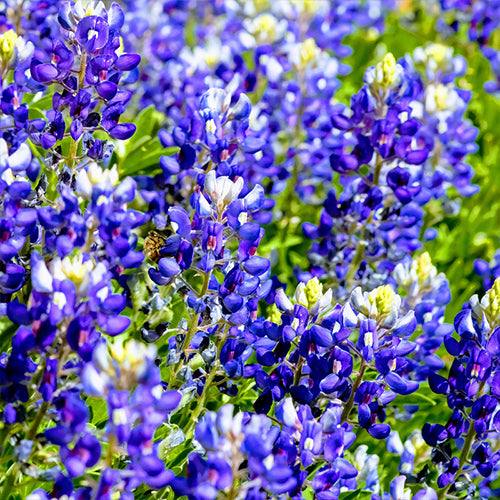
How To Grow Texas Bluebonnet From Seeds
Share
What is Texas Bluebonnet?
Texas Bluebonnets, scientifically known as Lupinus texensis, are beautiful wildflowers native to Texas. They are the state flower of Texas and are highly cherished for their vibrant blue color and unique shape. Texas Bluebonnets are a type of lupine and belong to the legume family.
How to Grow Texas Bluebonnets from Seeds?
Ideal time to plant bluebonnets is in the fall, especially if planting by seed. Growing bluebonnets from seed can be challenging due to their tough seed coat and low germination rates. But, scarification to the seeds using sandpaper to roughen the seed coat may help it along. Soak Bluebonnet seeds in lukewarm water over night before sowing outdoors.
In addition, some residual seeds can remain in the soil for the following year. As the hard seed coats wear down from abrasion and decay, with some water the seedlings begin to sprout.
The hard seed coat is an excellent mechanism for survival during unfavorable years, but it can frustrate the gardener who wants a spring display of colorful blooms the first year after planting.
In order to reseed the Blubonnet wildflower, allow the pods form and drop their seeds.
Here are the steps to successfully grow these stunning wildflowers:
Step 1: Seed Collection
Collect Texas Bluebonnet seeds from mature plants during late spring or early summer. Look for dried seed pods that have turned brown and are starting to crack open.
Step 2: Seed Preparation
Scarify the seeds by gently nicking or scratching the hard seed coat. This helps to improve germination rates by allowing water to penetrate the seed.
Step 3: Soil Preparation
Choose a sunny location with well-draining soil. Texas Bluebonnets prefer sandy or loamy soil. Prepare the soil by removing any weeds or grass and loosen it with a garden fork or tiller.
Step 4: Seed Sowing
Scatter the scarified seeds over the prepared soil. Avoid burying the seeds too deep, a light covering of soil or pressing them gently into the soil is sufficient. Sow Texas Bluebonnet seeds directly into prepared soil 1/8 inches deep, which is loosened and weed free.
Step 5: Watering and Care
Water the seeds immediately after sowing and keep the soil consistently moist until germination occurs. Once the seedlings emerge, gradually reduce watering frequency to encourage deep root growth. Keep the soil moist until germination.
Step 6: Maintenance
Remove any competing weeds or grass that may hinder the growth of the Texas Bluebonnets. Apply a balanced fertilizer during the growing season to promote healthy plant development.
Step 7: Enjoy the Blooms
With proper care and patience, your Texas Bluebonnets will bloom in spring, filling your garden with their iconic blue flowers. Enjoy the beauty and fragrance of these native wildflowers.
Conclusion
Growing Texas Bluebonnets from seeds is a wonderful way to add a touch of natural beauty to your garden. By following the steps outlined above, you can successfully cultivate these iconic wildflowers and enjoy their stunning blooms. Embrace the spirit of Texas by nurturing these native plants and creating a vibrant display of blue in your outdoor space.

